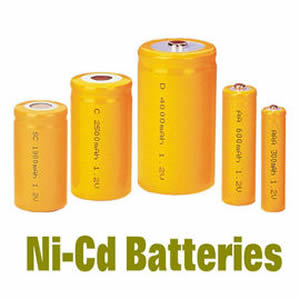Difference between NiCad, NiMH and Lithium battery
Key difference: NiCad stands for Nickel–cadmium, whereas NiMH stands for Nickel–metal hydride. Both use nickel oxide hydroxide (NiOOH) as their positive electrode. There are many different types of batteries that use lithium as their positive electrode, the most common types of lithium batteries are the lithium-ion and lithium-polymer batteries. Li-ion batteries are most popular among the three.
 NiCad, NiMH and Lithium batteries are three of the most commonly used batteries today. There are used in everything from regular AA or AAA pencil cells to in devices such as laptops, cameras, phones, etc. Like every type of technology, each one has its own set of advantages and disadvantages.
NiCad, NiMH and Lithium batteries are three of the most commonly used batteries today. There are used in everything from regular AA or AAA pencil cells to in devices such as laptops, cameras, phones, etc. Like every type of technology, each one has its own set of advantages and disadvantages.
NiCad stands for Nickel–cadmium, whereas NiMH stands for Nickel–metal hydride. Both use nickel as their primary metal to build the battery around, typically they use nickel oxide hydroxide (NiOOH) as their positive electrode. They do differ in the materials used as the negative electrodes. A NiCad battery uses cadmium as its negative electrode, whereas a NiMH battery uses a hydrogen-absorbing alloy. This increases the capacity of a NiMH battery to make it last 2 or 3 times more than a comparable NiCad battery.
Both NiCad and NiMH are types of rechargeable batteries. However, while there are many different types of batteries that use lithium as their base, the most common types of lithium batteries are the lithium-ion (Li-Ion) and lithium-polymer (Li-Po) batteries, which are rechargeable.
 Lithium-ion batteries have become the new standard of batteries in the electronic industry, especially for portable consumer electronics. The benefit of using lithium-ion batteries is that they produce the same charge as NiMH batteries but, tend to weigh significantly less. Hence, making them ideal for portability. Another benefit of li-ion batteries, is that they tend to charge faster than the other two, and deplete slower than the other two. In comparison, NiMH come in second, whereas NiCad come in third in this regard.
Lithium-ion batteries have become the new standard of batteries in the electronic industry, especially for portable consumer electronics. The benefit of using lithium-ion batteries is that they produce the same charge as NiMH batteries but, tend to weigh significantly less. Hence, making them ideal for portability. Another benefit of li-ion batteries, is that they tend to charge faster than the other two, and deplete slower than the other two. In comparison, NiMH come in second, whereas NiCad come in third in this regard.
Li-ion batteries also tend to have a longer lifecycle hence not needing frequent replacements, at least as compared to the NiCad or NiMH batteries. The NiMH batteries come in second in this regard, whereas NiCad comes in third with the shortest lifespan.
 It could be said that the NiMH battery were an improvement on the NiCad batteries, while the lithium batteries are an improvement over the NiMH battery. However, that does not mean that it has no faults. Li-ion batteries do have a slight risk of erupting or exploding in high heat, such as in hot cars, direct sunlight, or if tampered with or faulty. Yet there is only a minor risk of that happening and the technology is constantly improving to avoid that scenario.
It could be said that the NiMH battery were an improvement on the NiCad batteries, while the lithium batteries are an improvement over the NiMH battery. However, that does not mean that it has no faults. Li-ion batteries do have a slight risk of erupting or exploding in high heat, such as in hot cars, direct sunlight, or if tampered with or faulty. Yet there is only a minor risk of that happening and the technology is constantly improving to avoid that scenario.
Comparison between NiCad, NiMH and Lithium battery:
|
|
NiCad battery |
NiMH battery |
Lithium battery |
|
Type of |
Battery |
Battery |
Battery |
|
Material |
Nickel–cadmium |
Nickel–metal hydride |
Lithium lithium-ion (most commonly) |
|
Description |
A battery that uses nickel oxide hydroxide (NiOOH) as its positive electrode (anode), and cadmium as its negative electrode (cathode) |
A battery that uses nickel oxide hydroxide (NiOOH) as its positive electrode (anode), and a hydrogen-absorbing alloy as its negative electrode (cathode) |
A battery that uses lithium as its positive electrode (anode), the negative electrode (cathode) can vary. Most common type of lithium batteries are the lithium-ion batteries. |
|
Usage |
Were popular once but have since been replaced by NiMH in popularity. |
Was widely used in portable consumer electronic devices but have now been replaced by Li-ion batteries. |
Widely used in portable consumer electronic devices. Li-ion batteries are commonly used in laptops, cameras, phones, etc. |
|
Life |
Lower charge density (shorter life) than NiMH batteries. |
Higher charge density (longer life) than NiCad batteries |
High charge density (long life) |
|
Recharging |
Most commonly rechargeable |
Most commonly rechargeable |
Lithium-ion batteries are rechargeable. Other lithium batteries are not. |
|
Weight |
Heavier in weight |
Lighter than NiCad |
Lighter than NiMH |
|
Temperature |
Does not perform well in cold temperatures |
Performs better in cold temperatures |
Performs best in cold temperatures among the three |
|
Life cycles |
Longer life cycles |
Fewer life cycles compared to NiCad |
Increased life cycles over NiCad and NiMH |
|
Self-discharge |
Lower self-discharge level than NiMH |
Higher self-discharge level than NiCad |
Low self-discharge |
Reference: Wikipedia (NiCad, NiMH, Lithium, Li-ion), Tool Crib, eBay Image Courtesy: lithiumlifepo4battery.com, dmohankumar.wordpress.com, swling.com









Add new comment